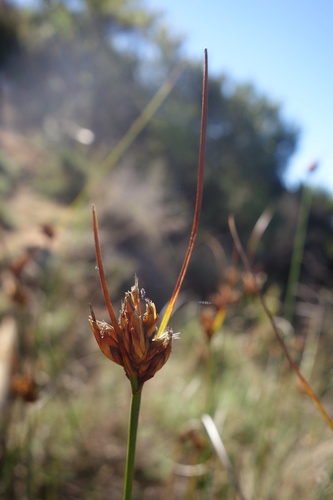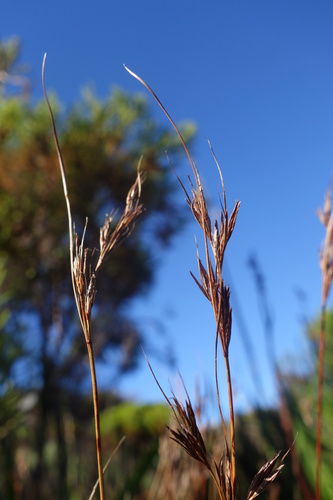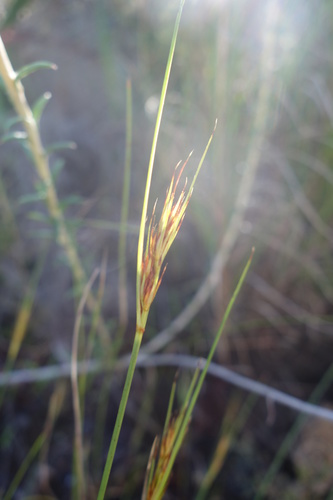You will sometimes notice that your images have been identified not to species, but to one of three main groups of southern African Schoenus. This might lead to you questioning: 1) what are these three groups, 2) which species pertain to them, and 3) why are they referred to as groups? I will provide you with a brief explanation.
Schoenus "compar-pictus" group
This group contains some of the most conspicuous southern African Schoenus species. Distinguishing characteristics include:
- dilated primary inflorescence bracts or membranaceous marginal extensions on the bracts. These bracts either partially or entirely cover the spikes;
- sheaths and ligules that are usually open and membranaceous; and
- many species in this group have sticky culm bases and flowering heads.
The two images below show Schoenus compar (sticky) to the left and Schoenus pictus (dilated primary inflorescence bracts) to the right:


More detailed images of this group of Schoenus can be found on the following websites:
https://en.wikipedia.org/wiki/Schoenus_compar
https://en.wikipedia.org/wiki/Schoenus_megacarpus
Species in this group include:
Schoenus compar, Schoenus arenicola, Schoenus pictus, Schoenus pseudoloreus, Schoenus aureus, Schoenus megacarpus, Schoenus comparoides, Schoenus albovaginatus and Schoenus triticoides.
To date, Schoenus filiculmis is considered in this group, but several characters and preliminary phylogenetic analyses show that this placement is doubtful.
Schoenus "cuspidatus" group
This is the group with the highest number of southern African Schoenus species. It is a confusing group, with a lot of intermediate forms suggesting possible hybridization. Species in this group have leafless flowering stems and a characteristics spikelet with a distinct prophyll.


Detailed images of the characteristics spikelets are shown on here:
https://en.wikipedia.org/wiki/Schoenus_cuspidatus
https://en.wikipedia.org/wiki/Schoenus_bolusii
This is the most species-rich of the three southern African Schoenus groups. Based on current knowledge, the species in this group include:
Schoenus auritus, Schoenus graminifolius, Schoenus ligulatus, Schoenus exilis, Schoenus bolusii, Schoenus submarginalis, Schoenus crassiculmis, Schoenus purpurascens, Schoenus prophyllus, Schoenus calceolus, Schoenus quartziticus, Schoenus limosus, Schoenus brunnescens, Schoenus compactus, Schoenus crassus, Schoenus loreus, Schoenus galpinii, Schoenus riparius, Schoenus cuspidatus, Schoenus graciliculmis, Schoenus australis and Schoenus inconspicuus.
It is unclear at this time whether Schoenus bracteosus pertains to the "compar-pictus" or "cuspidatus" group.
Schoenus "Epischoenus" group
Species in this group used to be placed in the genus Epischoenus. They are generally associated with wet habitats and lack leaves on both their flowering stems and bases.
Three examples of species in this group are described on the following pages:
https://en.wikipedia.org/wiki/Schoenus_quadrangularis
https://en.wikipedia.org/wiki/Schoenus_neovillosus
https://en.wikipedia.org/wiki/Schoenus_gracillimus
Species included in this group are Schoenus complanatus, Schoenus quadrangularis, Schoenus selinae, Schoenus rigidus, Schoenus crinitus, Schoenus adnatus, Schoenus schonlandii, Schoenus lucidus, Schoenus neovillosus and Schoenus gracillimus.
Schoenus dregeanus is an odd species that has characters intermediate to the "cuspidatus" and "Epischoenus" groups.
Why groups and not sections or clades?
This is a decision I have made based on the available evidence. At this time, there are still a few species which are impossible to place with certainty (e.g. Schoenus bracteosus, Schoenus filiculmis and Schoenus dregeanus). In addition, there could be gene exchange among the three different groups, meaning that they are not completely delineated from each other.
Another reason is that I do not see a reason at this time to keep dividing and dividing.
Best of luck with the hunt!









